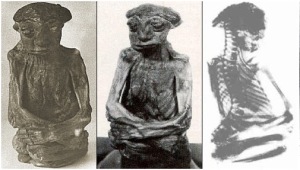
The San Pedro Mountains Mummy, claimed by some to be the remains of a Nimerigar (Wikipedia)
For the most part, the Fair Folk of North America are more congenial than their European counterparts. Though exceptions certainly exist, they are more likely to be friendly to mortals than the average sídhe or pisgy, for example.
One clear exception is found among the peoples of the Great Plains. The little folk of that vast region between the Rocky Mountains and the Mississippi River are most often depicted as a race of dangerous cannibals. These “cannibal dwarves” or “wild people” are known to virtually every tribe in the region—and even into the Rocky Mountains. They are called by a multitude of names, including:
- Gada’zhe, mong-thu-jah-the-gah, or ni’kashinga man’tanaha (Omaha-Ponca)
- Hecesiiteihi (Arapaho)
- Mi’-a-gthu-shka or mialuka (Osage)
- Nimerigar (corruption of Shoshoni nemetakah, numu-tuhka)
- Nirumbee or awwakkulé (Crow)
- Nunnupi or nunumbi (Comanche)
- Vo’estanehesano (Cheyenne)
Cannibal dwarves are dangerous and aggressive by nature. Like the faeries of Europe, they sometimes kidnap children or use their magical powers to harm people. They hunt with bows and poisoned arrows, and are able to inflict wounds without breaking the skin—also a point in common with their European cousins. They have their own villages, trails, and other places. They can only be seen, however, when they want to be or are taken unawares.
Descriptions of these little folk vary somewhat from community to community. In Arapaho legend, they are immensely strong. According to the Omaha, they are tiny one-eyed cyclopes. The Crow see them with pot bellies and no necks. In other Siouan traditions (Osage, Omaha, and Kansa, for example), they sometimes have wings.
Whatever the particulars, these beings are usually said to be the size of children (generally 2–4 feet tall), dark-skinned, and extremely aggressive. They usually have squat necks and sharp teeth. Some storytellers say they have the power to turn themselves invisible, while others say they are hard to spot simply because they move with incredible speed. Some suggest that their warlike temperament comes because they must be killed in battle in order to reach their dwarfish afterlife. Others say that they are gluttons who habitually kill more than they can eat just because they can.
These beings are almost always hostile to human beings. There are some Crow legends, however, in which a nirumbee helps a mortal, especially during a sacred fast or in return to a kindness done to them. Furthermore, they are said to have played a major role in shaping the destiny of the Crow nation through the dreams of the Crow chief Plenty Coups in the early twentieth century. They thus can be seen as imparting spiritual wisdom despite their overall hostility to humans.

